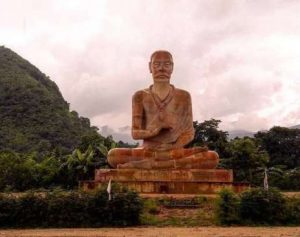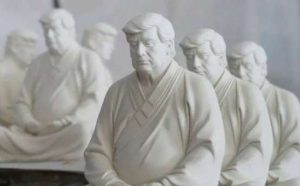
At the beginning of October, I was invited to participate in a workshop on Buddhism, violence, and non-violence, hosted by American University and sponsored by the Uberoi Foundation for Religious Studies. In my presentation, I looked at some of the texts and practices in Japan that complicate the seemingly straightforward Buddhist understanding of violence and non-violence.
The emphasis of Buddhism on non-violence (Skt: ahiṃsā), formulated in the first precept (Skt: śīla) and, alternatively, translated as non-injury or non-harm, is well-known. The first precept and the general exhortation of ahiṃsā seem quite straightforward. However, there are texts and practices in Mahāyāna Buddhism, e.g. the practice of self-immolation, that complicate the issue.
Today, I would like to look at some of these phenomena, interpret them in the light of Mahāyāna Buddhist ideas and texts, suggest a new conception of violence and non-violence, and identify some implications for contemporary affairs. Given the current state of the world, these ideas are not just idle speculations but gain a new sense of urgency.
I’d like to begin with identifying four kinds of harm implied and inflicted in some Buddhist texts and practices: 1) self-harm for the benefit of the self; 2) self-harm for the benefit of others; 3) other-harm for the benefit of the other; and, 4) other-harm for the benefit of the self. This typology is based on the us-versus-them rhetoric found in many a description of violent conflicts.

1) is exemplified by the so-called “passage to Fudaraku (fudaraku tokai); 2), by the practice of self-mummification (sokushinbutsu); 3) by the sarin gas attack of members of Aum Shirikyō on the Tokyo subway on 20 March 1995; and 4), by the support some Zen Buddhist thinkers and priests lent to Japanese militarism leading up to the Pacific War and, ironically, any just war theory.
Due to time constraints, I would like to focus on the first two practices. They also seem to align more easily with the Buddhist doctrine of no-self (Skt: anātman). Practices inflicting self-harm for the benefit of another, such as self-immolation, evoke countless stories in the Jātaka Tales and Mahāyāna sūtras (such as the Vimalakīrti Sūtra) exemplifying the bodhisattva ideal.
The “passage to Fudaraku” describes the practice of jumping off boats into the ocean while chanting the name of Amida (Amitābha) in order to attain re/birth in the Pure Land (Jp: ōjō). In some sense, these practitioners, historical or fictional, chose a controlled environment for their death to make sure that the last thought on their minds was the name of Amitabha Buddha.
In Edo Japan (1603–1868), a few Shingon monks underwent a six-year practice that included a diet of bark and pine needles called tree-eating practice (Jp: mokujikigyō), waterfall practice (Jp: takigyō), and drinking Urushi tea with the goal of mummifying themselves and becoming a “buddha in this very body.” It is believed that these monks sat in continuous practice and performed miracles.
These practices raise three central questions: 1) A metaphysical one: who inflicts harm, who is being hurt? 2) An epistemological one: what does the word “violence” refer to? and 3) A moral one: what kind of behavior is appropriate? Obviously, it is impossible to do justice to these three questions in 1,000 words. Therefore, I will briefly cite three texts to illustrate what is at stake.
To examine the nature of the victim and the victimizer, I will cite D. T. Suzuki’s thoughts on sword fighting. To explore the meaning of the word “violence” itself, I will take refuge in the Diamond Sūtra (Vajracchedikā Prajñāpāramitā Sūtra). And to solve the moral conundrum on “what’s the right thing,” I will turn to Dōgen’s Shōbōgenzō shoakumakusa.
D. T. Suzuki’s problematic application of the “doctrine of emptiness” (Skt: śūnyatāvāda) to sword fighting in particular and warfare in general is as follows: “As each of them is of emptiness and has no ‘mind’ [Jp: kokoro], the striking man is not a man, the sword in his hands is not a sword, and the ‘I’ who is about to be struck down is like the splitting of the spring breeze in a flash of lightning.”*
The Diamond Sūtra challenges our assumptions of what language actually refers to. Obviously, it does not address the term “violence,” but we can paraphrase it statements to read “so-called violence is not violence”** and “The Buddha explained that views about violence are not views about violence; therefore we call them such.”*** This is why I use the term “non/violence.”
Finally, in his commentary on the Dharmapada, Dōgen states, “At times, practice of faith and practice of the Dharma can be seen as different. But these separate teachings are the same. E.g., the śrāvaka’s adherence to the precepts is not different from the bodhisattva’s violation of the precepts.”**** In other words, “adherence to the [1. precept] is not different from violating it.”
“Violence the same as non-violence”? This sounds rather shocking. So how do we solve this conundrum? One of the problems is that many interpretations of this conundrum, such as the proposal to interpret the Mahāyāna Buddhist approach as antinomianism or even as a theory of amorality, utilize conceptual language and thinking that is external to the Buddhist tradition.
What I would like to do here is to fashion a moral framework from philosophical insights and concepts developed within the Buddhist tradition, more explicitly from Chengguan’s (738–839) “fourfold Dharma-world” (Ch: shifajie) and from what I call Dōgen’s “ethics of expression.” I believe that such a framework is better suited to disclose the Mahāyāna conception of non/violence.
Dōgen suggests: “Now, I and the other engage in liberative practices and enter into a . . . dialogue; he and an other engage in liberative practices and enter into a . . . dialogue. In me [as well as in him], there is expression and there is non-expression.”***** In short, every statement, metaphysical or moral, highlights one aspects of our common humanity and obscures an other.
Therefore, I translated Chengguan’s “fourfold Dharma-world” into a fourth-person philosophy:
“While a first-person approach is driven by my narrative, a third-person approach by the grand narrative, and a second-person approach by TWO potentially conflicting stories, a fourth-person approach engages a multiplicity of vantage points in a creative multilogue.”******
With the help of these two thinkers, I have been able to develop a philosophical framework to rethink the concept of non/violence as non/violence to solve a few central puzzles: why do some acts seem moral from one perspective and immoral from another? Why is some harm considered to be acceptable and other harm is not? How can we navigate these labyrinths?
So where does this leave us? I would like to leave you with a few guidelines: 1) There is no unified theory of non/violence but only contextualized theories; 2) The discourse on morality and the precepts have four dimensions: personal/subjective, universal/normative, relational, and multilayered; 3) Every act and every concept is, simultaneously, life-affirming and life-negating; and finally, 4) appropriate behavior has to be negotiated in a multilogue that includes, but is not limited to, rational discourse but embraces all existential modalities. Both a first- and a third-person approach to non/violence are insufficient. The former is subjective, the latter is external to the experiences of human beings and silences as well as alienates them.
We need to negotiate “appropriate behavior” in a multilogue that includes everyone affected and involved; we need to protect all participants in a conflict; we need to recognize our interwoven histories and the current power structures; most of all, we need to listen to those who are silenced and marginalized. This “is the teaching of the Buddha,” this is the way of the bodhisattvas.
* Yagyū Tajima no Kami Munenori as qtd. by D.T. Suzuki as qtd. in Victoria 2010, 117.
** T 235.8.749b25
*** T 235.8.752b18-20
**** DZZ 1: 280.
***** DZZ 1: 304.
****** Kopf 2021, 2023.
References
Kopf, Gereon. 2021. “How to make Philosophy of Religion Relevant for the Future.” In Philosophy of Religion: Big Question Philosophy for Scholars and Students, ed. David Rohr. 3 December 2021 (https://philosophyofreligion.org/?p=525634#more-525634).
Kopf, Gereon. 2023. “The Theory and Practice of the Multi-Entry Approach.” In Diversifying Philosophy of Religion: Critiques, Methods, and Case Studies, eds.: Nathan Loewen and Agnieszka Rostalska, Chapter 8. New York: Bloomsbury Academic.
Ōkubo, Dōshū, ed. 1969–70. Dōgen zenji zenshū (Complete Works of Zen Master Dōgen). Two volumes. Ed. Tokyo: Chikuma Shobō. [Abbr. DZZ]
Takakusu, Junjirō and Kaigyoku Watanabe, eds. 1961. Taishō shinshū daizōkyō (The Taishō Edition of the Buddhist Canon). Tokyo: Taishō Shinshū Daizōkyō Kankōkai. [Abbr. T]
Victoria, Brian. 2010. “The ‘Negative Side’ of D.T. Suzuki’s Relationship to War.” Eastern Buddhist Vol. 41, No. 2, 97–138.
See more
補陀落渡海 (Kagawa Gallery)
Related features from BDG
Buddhistdoor View: Finding the Peacemakers in a New, Terrible War
The Path of Engaged Buddhism in a Divided World: An Interview with Ven. Pomnyun Sunim
The Practice of Nonviolence
Does Buddhism Hold the Instincts for War?
Healing the World: The First Problem
















